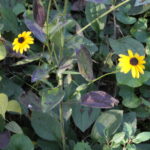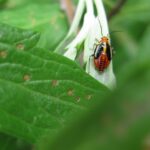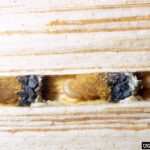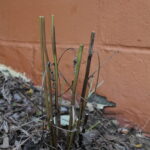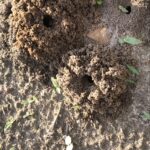Most experienced gardeners will tell you that removing the dead foliage and stems of perennials and annuals in the fall is a great way to help next year’s garden get off to a good start. Removing the stubble and leaves can remove overwintering fungi and insects that can attack plants in the spring. It also helps the garden soil dry more quickly so that you can plant earlier the following spring. Despite these advantages, these practices may also destroy or remove the habitat of the same solitary bees that gardeners want to lure into their garden.
Protect plants and pollinators this fall by identifying areas where you will focus on pollinator habitat conservation and other areas where you will focus on pest control. In this way, you will be able to leave nesting areas undisturbed for pollinators while removing pests from other areas. Consider moving the pollinator areas around your garden over a multiple year period to prevent pest buildup in any one area.
Fungal diseases, like Septoria leaf spot can build up in perennial plantings and cause summer defoliation. Remove, or mow plants in the late fall to remove overwintering fungi that will attack next year’s plants. Focus your removal on part of the garden that has the most heavy infestation of diseased leaves.
Four lined plant bugs can distort and discolor leaves of many perennials in late spring and early summer. Remove or mow perennial beds in the fall to destroy eggs that were laid in stems during the summer. This will leave fewer plant bugs to attack the garden in the following spring. Focus your removal efforts on areas of the garden that suffered from injury this summer.
Many solitary bees, like the small carpenter bee, orchard and mason bees can use stems of last year’s perennials to build their nest. Some species require hollow stems. Others will excavate tunnels they need. Adult bees who lay eggs in these tunnels in spring and early summer will also provide enough food for their young to grow and develop during the rest of the growing season. A new generation of bees will emerge the following spring to start the cycle over again.
- Small carpenter bee in stem. Photo by Howard Ensign Evans Colorado State University, Bugwood.org
- Echinacea stems cut for winter will provide habitat for solitary bees next year.
You can protect the habitat of stem nesting bees by cutting stems of varying heights that bees will use next spring. Although the stems will be visible in early spring, they will soon be covered by vigorous growth as the season progresses.
Undisturbed soil provides nesting sites for many species of soil dwelling bees. Many of these bees are extremely good pollinators and should be left undisturbed through the summer to complete their life cycle. Designate areas where you will not dig for at least a year in order to conserve these pollinators.
Resources
Watch a how a blue orchard bee makes and provisions its nest in a hollow stem.
https://www.youtube.com/watch?v=oPbH1YhsdP8&ab_channel=DeepLook
Recommended Indiana Native Plants for Attracting Pollinators.
https://extension.entm.purdue.edu/publications/POL-6/POL-6.html
Bees: An Identification and Native Plant Forage Guide, Heather Holm 2017
www.pollinatorsnativeplants.com
Purdue Tree, Shrub, and Flower Doctor Apps.
PurduePlantDoctor.Com
Purdue’s Winter Cluster Webinar on YouTube: https://youtu.be/9YrpvR_inCI
